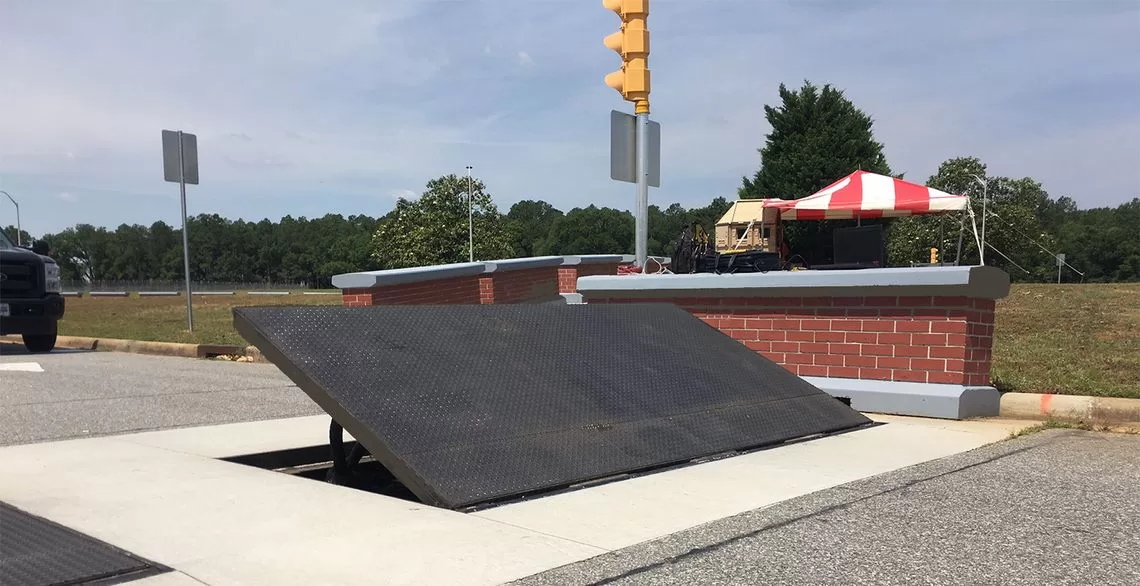The 6-Second Trick For Wedge Barriers
Table of ContentsFascination About Wedge BarriersSee This Report about Wedge Barriers

8 Easy Facts About Wedge Barriers Explained
The remaining pressure applied to
the cam camera deploy the wedge plate 16 may might provided offered an electromechanical actuator 84 or other actuator. The springtime assembly 54 and the actuator 84(e. Wedge Barriers. g., electromechanical actuator)might operate together to equate the cam and raise the wedge plate 16.
As stated over, the spring assembly 54 puts in a constant pressure on the web cam, while the electromechanical actuator may be regulated to exert a variable pressure on the camera, thereby making it possible for the lifting and lowering( i. e., releasing and withdrawing )of the wedge plate 16. In specific embodiments, the constant pressure used by the springtime assembly 54 may be flexible. g., electromechanical actuator) is handicapped. As will be appreciated, the springtime assembly 54 might be covered and safeguarded from particles or other components by a cover plate(e. g., cover plate 68 displayed in FIG. 4) that might be substantially flush with the elevated surface area 38 of the structure 14. As discussed over, in the released position, the wedge plate 16 serves to obstruct accessibility or travel past the obstacle 10. The obstacle 10(e. g., the wedge plate 16 )may block pedestrians or cars from accessing a residential or commercial property or pathway. As gone over over, the obstacle 10 is affixed to the support 30 secured within the foundation 14,

front brackets 71. As an outcome, the linkage settings up 72 might visit this site right here pivot and revolve to enable the collapse and extension of the affiliation settings up 72 throughout retraction and implementation of the bather 10. The linkage settings up 72 cause movement of the wedge plate 16 to be restricted. For instance, if a car is taking a trip in the direction of the released wedge plate 16(e. For instance, in one condition, the safety and security legs 86 may be extended throughoutmaintenance of the barrier 10. When the safety legs 86 are deployed, the safety legs 86 support the weight of the wedge plate 16 against the surface 12. As an outcome, the lifting mechanism 50 might be shut down, serviced, eliminated, replaced, etc. FIG. 5 is partial viewpoint sight of a personification of the surface-mounted wedge-style barrier 10, illustrating the cam 80 and the webcam surface areas 82 of the lifting device 50. Especially, two cam surfaces 82, which are described as lower camera surfaces 83, are positioned below the camera 80. The lower web cam surface areas 83 may be fixed to the surface 12 (e. As an example, the reduced cam surfaces 83 and the placing plate 85 might form a single item that is safeguarded to the support 30 by screws or other mechanical bolts. Additionally, two cam surfaces 82, which are described as upper camera surfaces 87, are placed above the look at this web-site webcam 80 and combined to (e. In other embodiments, interfering layers or plates might be positioned in between the surface 12 and the reduced web cam surfaces 83 and/or the wedge plate 16 and the upper web cam surface areas 87 As mentioned above, the camera
80 translates along the webcam surfaces 82 when the wedge plate 16 is lifted from the pulled back position to the released position. Furthermore, as mentioned over, the springtime assembly 54 (see FIG. 3 )might provide a force acting on the webcam 80 in the direction 102 using springtime pole 58, which might decrease the pressure the electromechanical actuator 84 is called for to apply to the camera 80 in order to activate and lift the wedge plate 16. 1 )to the deployed placement(see FIG. 4). As revealed, the cam 80 includes track wheels 104(e. g., rollers), which call and convert along the webcam surface areas 82 throughout procedure.